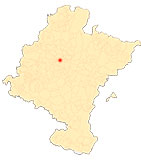Basilica of St. Ignatius of Loyola
By Ricardo Fernández Gracia
|
|
|
|
|
|
|
|
|
|
|
|
|
|
|
|
|
|
|
|
|
|
|
|
|
|
|
|
|
|
|
|
|
|
|
An unfinished façade
Thanks to the text of Father Alesón in the Annals of Navarre, we know that the fortification-shaped façade, with two battlements-spandrels, was to be fill in with a sculpture of Saint Ignatius with an emblem. This is the chronicler's text:
All of it, which, though small, is very neat, consists of the ornaments of architecture, in which the eyes have their bait; but there is no lack of others which may be more delicate and even delightful to the intellect. These are many expressive hieroglyphs of the subject. We will only place here the most powerful of them all because it is sculpted on the pedestal on which the marble military statue of our glorious captain is to be placed, armed as he was when he was wounded and fell from that very post, and it is at the top, in the middle of the crenellated façade, in the likeness of an ancient castle. The body of this business is a very luxuriant wheat plant, whose waste falls to the ground, and the soul of the business consists of these words taken from the Gospel: Cadens in terram multum fructum affert (Joannes ch. 12).
Part of this registration is repeated in the central decorative oval containing the IHS, the work of Juan Miguel Goyeneta (1743). The lower registration still reads: Nisi granum frumenti cadens in terra mortuum fuerit ipsum solum manet (Unless a grain of wheat falls into the earth and dies, it remains alone; but if it dies, it bears much fruit) (John, 12, 24-26).
The complex is very simple, based on a large rectangular wall framed by giant pilasters, on which are superimposed three half openings - a lintelled door and two windows with their period grilles -, the large oval made in 1743 by the aforementioned Juan Miguel Goyeneta and a pair of tondos with a helmet and arms on the inside. The complex is crowned by two brick belfries, which we have seen were used as battlements of the walled enclosure.
file Diocesan of Pamplona. Government of the Diocese. administrative office de Cámara. Boxes 293, 294, 295, 296 and 297.
ASCUNCE, E., Íñigo de Loyola, capitán español, y el castillo de Pamplona, Madrid, Aguado, 1939.
AZANZA LÓPEZ, J., La arquitectura religiosa del Barroco en Navarra, Pamplona, Government of Navarre, 1998.
EGUILLOR, J. R., Loyola, historia y arquitectura, San Sebastián, Etor, 1991.
FERNÁNDEZ GRACIA, R., El retablo barroco en Navarra, Pamplona, Government of Navarre, 2003.
FERNÁNDEZ GRACIA, R., "The Jesuits in Pamplona 1580-1767". Diario de Navarra, 28 April 2014, pp. 70-71.
FERNÁNDEZ GRACIA, R., "Heritage and identity (52). The basilica of San Ignacio in Pamplona". Diario de Navarra, 21 May 2021, pp. 62-63.
GARCÍA GAÍNZA, M.ª C. et al., Catalog Monumental de Navarra V. Merindad de Pamplona ***, Pamplona, Institución Príncipe de Viana, 1997.














